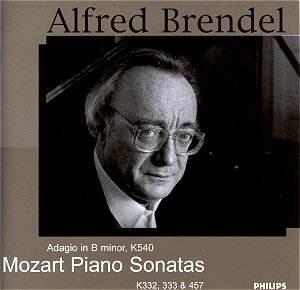Brendel has been a leading exponent of Mozartís piano
concertos since the beginning of his career but it took him a long time
to convince himself that he wanted to perform the sonatas. This may
account for the happy marriage between his deep artistic maturity and
a sense of spontaneous first delight which informs much of this disc.
Not, perhaps, in the first movement of K.332. I recently had some rather
didactic Mozart from Richter (at the start of a nonetheless obligatory
1966 Aldeburgh recital Ė BBCL 4082-2) and I feared I might be in for
some more. The steady tempo is magisterially unfolded rather in the
manner of Otto Klemperer and, as sometimes happened with that conductor,
the result, for all its imposing dignity, is more a demonstration than
a performance. The slow movement is extremely beautiful. Note how the
"Alberti bass" becomes a little rocking poem in itself, and
how meaningful are the repeated notes that accompany the second theme.
The finale has the air of a real improvisation; listen to how he slips
into the "dolce" melody after the opening cascade, and how
lovingly he plays the minor key episodes. He throws in the odd bit of
decoration here and there Ė did he make it up on the spur of the moment?
K.333 is quite different. The first movement is a model
of grace and a rather disarming feature throughout the disc but particularly
notable here are little details like chords that are split one time
round but not the next, contributing to the impression that Brendel
is ad libbing the music before a privileged circle of friends. Brendel
is also acutely sensitive to the tone colours of the different keys
the music passes through Ė how warm this E flat major is! In the finale
he seemingly improvises the second episode on the spot, with sudden
impetuous accents on the syncopated left-hand chords.
The C minor is different yet again, with the outer
movements full of impetuosity Ė the triplets in the first movement even
bring a quickening in tempo. The slow movement will surely go down in
the annals as a classic of Mozart playing, not least for Brendelís sensitivity
to the musicís colouring as it moves from one key to another. After
a warm E flat major start, a shaft of light seems to enter the music
as it goes into B flat. And then, as Mozart goes deep into the flat
keys, the sound gets richer and richer. Iíd dearly like to know why,
at a certain point in the G flat major episode, he brings out the lower
right-hand voice as the melody rather than the upper one, since Iím
sure he must have some reason for drawing our attention to that particular
motive.
The B minor adagio finds him a shade didactic. I recently
reviewed a period-piano performance by Ronald Brautigam (BIS-CD-1266/1267)
which moved this long piece on a little more passionately. But I canít
emphasise enough that, even when he is didactic (but it should be evident
from the above notes that this is a matter of one movement out of nine
plus this adagio) Brendel makes it clear that these are great sonatas,
classics to put alongside Beethoven and the best of Haydn, a fact not
always so evident in student performances. If you are really into period
pianos, these wonít be for you (but try them just the same for, unlike
Arrau, who also turned to these sonatas in late maturity, Brendel keeps
his Steinway Ė I presume Ė remarkably lithe and slender); and if you
donít insist on modern sound the claims of Gieseking are very strong.
But much here will surely be listened to by future generations as a
locus classicus both of how to perform these sonatas and of Brendelís
own piano playing.
Christopher Howell


